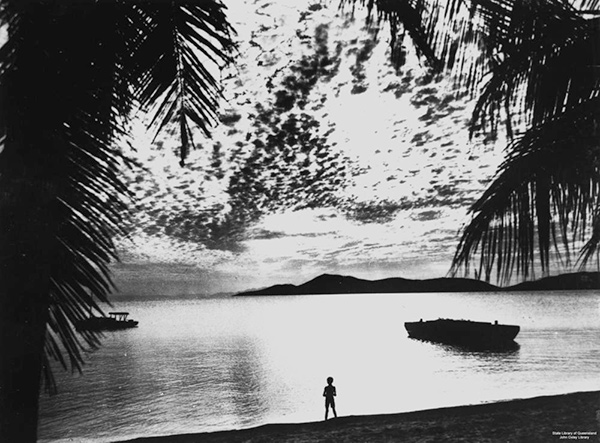Background
In April 2014, Palm Island Aboriginal Shire Council decided to open up the island to create tourism opportunities to help build economic opportunities for the local community. A Tourist Open Day was established where the general public were able to travel to Palm Island and undertake tours operated by local people, including a historical exhibition developed by the Bwgcolman Indigenous Knowledge Centre (IKC).
This case study is about the collaboration between a remote Aboriginal and Torres Strait Islander community and State Library of Queensland with other collecting institutions to utilise collection material to enable them to tell the perspectives of their history.
Description
The Palm Island & Our People exhibition is a chronology of significant events on Palm Island, commencing with the story of the first forced placement of Aboriginal and Torres Strait Islander people from 1918 and the traditional owners who previously occupied the Island before it was gazetted as a Government Reserve in 1916.
An IKC Coordinator undertook research and collected information from various institutions including State Library of Queensland, Queensland State Archives, AIATSIS, Australian Maritime Museum, Australian War Memorial and James Cook University. As this was the first time the Exhibitions Project Manager had worked with an IKC and they had limited knowledge about Palm Island, an Indigenous Services Program Officer accompanied them to Palm Island to gain a knowledge and understanding of the community and its history. The other objective of this visit was to begin to build a positive working relationship between the two parties. This enabled the coordinator and other nominated community representatives to visit the State Library and start work on identifying both existing and new collection material for the exhibition.
As the historical exhibition grew with further research undertaken with the assistance from the State Library and various donations over the years by private donors, the Council agreed to launch the expanding exhibition in its new location in March 2018 as part of the community’s 2018 centenary commemorations. The library invited the Bwgcolman IKC to co-curate an exhibition to be showcased at the State Library.
A cohesive and respectful partnership between State Library’s exhibition team, IKC Coordinator and Palm Island community representatives was evident throughout the development of the exhibition. All aspects of the exhibition including the promotion and content were approved by the IKC Coordinator and community representatives before it was produced.
The Program Officer identified a culturally-appropriate process for the exhibitions team to consult and explain conditions regarding access to collection materials with the IKC Coordinator and community representatives. The IKC Coordinator advised that community representatives did not feel comfortable engaging with the exhibitions team directly to seek content. Therefore, the IKC Coordinator was nominated by the Council and community as the contact person for any queries regarding the collecting and use of content, delivery and design for the promotion of the exhibition.

Outcomes
A special event for Palm Island community representatives to view all collection items from Palm Island was organised during their visit in Brisbane, to promote the existence and availability of these items for future access.
The importance of acquiring contemporary material for the John Oxley Collection was identified during the planning process. A private collection of photos from a freelance journalist who covered the 2018 centenary events, a digital story and five oral histories were recorded during the week leading up to the official opening of the exhibition. This content is accessible from State Library’s catalogue, with copies provided to each Elder and their families. Culturally-appropriate consultation with each participant was undertaken by the IKC Coordinator on Palm Island prior to the interviews, to ensure they understood the conditions of their consent to being recorded.
All questions prepared by the exhibitions team were reviewed by the Program Officer, Indigenous Services, provided to the IKC Coordinator and amended if required. The IKC Coordinator explained to each participant the reasons and conditions outlined in the consent form to ensure they understood before they signed it.
Before commencing the interviews, the Program Officer briefed the film maker and other support staff, advising them of the sensitivity of the questions and that responses may not be forthcoming or emotional. Although timeframes were set for each interview, the Program Officer advised that there will be moments where filming will need to be paused or ceased if the participant did not feel comfortable with continuing.
Lessons learnt
The IKC Coordinator was nominated by the community and the Palm Island Aboriginal Shire Council as the key community contact, which worked well for all involved. Her local knowledge of the community and family histories was integral to ensure the stories included in the exhibition were culturally cleared by the appropriate local representatives. Her assistance during their visit to Brisbane allowed the community representatives to see the positive working relationship she has with State Library and assisted them to build their own positive relationships with staff and other key stakeholders.
Having the Program Officer, Indigenous Services, as the conduit assisting both the community, State Library and other key stakeholders ensured that all parties were informed of all requirements/expectations, including cultural sensitivities, protocols and an awareness of the community’s significant history.
The timeframe to develop the exhibition was not long enough. The time required to undertake effective community consultation with the Palm Island community meant the exhibitions team did not have enough time to proofread content, resulting in some errors in the final design. The lesson learned here is that exhibition timeframes do not match the time required to consult effectively with an Aboriginal and Torres Strait Islander community due to cultural clearance requirements and other cultural impacts on communities, such as ‘sorry business’. Consultation with the community should have been done more than 12 months before the date of the launch.
These issues were noted for future exhibitions.
Related links
Palm Island & Our People exhibition and digital stories
Aboriginal and Torres Strait Islander Collections Commitments (PDF) – State Library of Queensland, 2019









